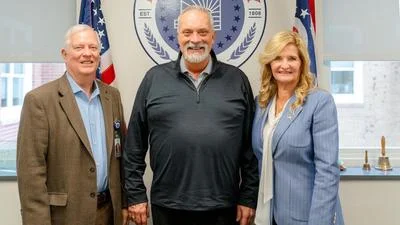Joshua Morrison/News
The Big Run Road Access, 8921 Big Run Road, outside of Gambier is one of nine access points for canoes and kayaks along the Kokosing River in Knox County.
MOUNT VERNON — The Kokosing River Water Trail offers 10 river access points for watercraft entry and exit, and they are maintained by multiple agencies, according to the Knox County Park District and the Kokosing/Mohican Water Trails map/guide. Parking areas are provided.
Two of these river access points, Riverside Park across from Greenwood Avenue and Memorial Park off of Mount Vernon Avenue and just upstream from the bridge, are both maintained by the city of Mount Vernon. About 1.1 miles downstream is Lower Gambier Road River Access at 1782 Lower Gambier Road, offered through the Knox County Park District.
The fourth river access point is Laymon Road Bridge River Access at 10115 Laymon road, provided by the Brown Family Environmental Center. Then comes Big Run Road Bridge River Access 5.4 miles downstream, making the Laymon Road-Big Run Road segment a nice two-hour plus trip of its own. There is excellent fishing in this area including smallmouth bass.
Next is Pipesville Road Bridge River Access at 12059 Pipesville Road, maintained by the Knox County Park District. This site is a good launch point for a day trip to the end of the water trail at the confluence of the Kokosing and Mohican rivers — 11.5 miles downstream, according to the river trails map and guide. A little more than three miles downstream is Millwood Road River Access at 11640 Bridge Street, with a gravel beach and good fishing, known for being the Kokosing State Scenic River’s “most scenic stretch.” However, this stretch is also recommended for experienced paddlers who “can make quick course changes,” according to the map/guide.
There is a point just below Factory Rapids where the river is pinched down to just 20 feet wide as paddlers navigate between sandstone boulders on Class III rapids. Riley Chapel Road Bridge River Access at 10300 Riley Chapel Road, where bald eagles are known to commingle, is co-managed by the Muskingum Watershed Conservancy District and Knox County Park District.
The last Kokosing River Water Trail access point is at Township Road 423, where the Kokosing and Mohican water trails meet to form the Walhonding River.
Knox County Park District Director Lori Totman said the park district is enthusiastic about its newest Kokosing River access point, called the Zuck Riparian Preserve, with its 15.5 acres purchased in 2015 in part through a grant from the Muskingum Watershed Conservancy District Partners. Located at 28300 Zuck Road, its location is between the Pipesville Road and Millwood Road river access points. Additional funding came from the Knox County Foundation and the Richard and Arline Landers Foundation.
“Once again, this demonstrates just how invaluable and beneficial these community collaborative relationships have been in the past and continue to be at present and will continue to be in the future,” Totman said.
[ee]
There is a point just below Factory Rapids where the river is pinched down to just 20 feet wide as paddlers navigate between sandstone boulders on Class III rapids. Riley Chapel Road Bridge River Access at 10300 Riley Chapel Road, where bald eagles are known to commingle, is co-managed by the Muskingum Watershed Conservancy District and Knox County Park District.
The last Kokosing River Water Trail access point is at Township Road 423, where the Kokosing and Mohican water trails meet to form the Walhonding River.
Knox County Park District Director Lori Totman said the park district is enthusiastic about its newest Kokosing River access point, called the Zuck Riparian Preserve, with its 15.5 acres purchased in 2015 in part through a grant from the Muskingum Watershed Conservancy District Partners. Located at 28300 Zuck Road, its location is between the Pipesville Road and Millwood Road river access points. Additional funding came from the Knox County Foundation and the Richard and Arline Landers Foundation.
“Once again, this demonstrates just how invaluable and beneficial these community collaborative relationships have been in the past and continue to be at present and will continue to be in the future,” Totman said.


